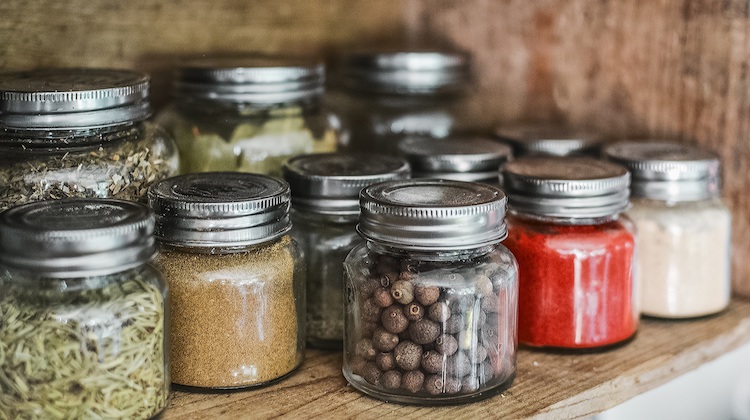Preparedness
6 Threats to Your Food Storage Cache and Ways to Protect It

When it comes down to it, one of the most important things you can do to make sure you and your family are prepared for a disaster situation — no matter how big or small — is to have a food storage plan in place.
Gaye Levy at Backdoor Survival is something of a food storage expert, and she has agreed to share some of her best tips with us. Read on to learn more.
Editor’s Note: You’re Survival Food Stockpile is Missing THIS!
The 6 Enemies of Food Storage
When it comes to stockpiling survival supplies, two items are always near the top my list: food and land to grow food. In my opinion, these are the two most valuable commodities to have if society crumbles. As I say that, I realize that land to grow food will be unattainable for many. On the other hand, almost everyone can acquire food and a place to store it.
By now, it’s common knowledge that during a disaster or other disruptive event, the grocery store shelves will be barren within a day or two. In addition, there is a substantial likelihood that amenities such as electricity and refrigeration will no longer be available. That’s why having food, and extensive knowledge of food storage techniques is so essential for long-term survival.
Since the beginning of Backdoor Survival, I have explored many areas of preparedness, from basic preparation to more extensive studies of self-sufficiency and the psychological aspects of survival. Beyond all else, however, I have taken a keen interest in food and food storage.
With the rapid escalation of food prices, I want to introduce you to the six enemies of food storage. These are important to keep in mind as you invest in food for your prepper pantry.
The Six Enemies of Food Storage
Storing food long-term is a daunting task. For the short-term, you can usually find a spare shelf or two in your kitchen cabinets and call it a day. Beyond the short-term, things start to get more complicated. Most food products have a shelf life limited by common factors, referred to as the Six Enemies of Food Storage:
- Temperature
- Oxygen
- Moisture
- Light
- Pests
- Time
As you will see, each of these factors are interrelated, often causing a domino effect and cumulatively affecting your stored items. Protect your food stores by following the tips below.
Temperature
Long-term food storage is best achieved by maintaining cool, constant temperatures. Ideally, temperatures between 40 and 70 degrees Fahrenheit are best for long-term storage. Anything warmer or cooler results in loss of color, nutrition, texture, and taste. A universal rule of thumb is that for every 18 degrees Fahrenheit increase in temperature, your food’s shelf life is cut in half.
The second factor when it comes to temperature is consistency. If you have a location where the temperature is 40 degrees one day and 70 the next, you will be facing loss in quality and shelf life. For instance, if you store your food in a garage where the temperature fluctuates between summer and winter, the shelf life will be based on the highest temperature, not the lowest.
Oxygen
Many nutrients can oxidize in the presence of oxygen. This creates rancidity and off-tasting food. Also, bacteria and microorganisms (larvae and bugs) thrive in an oxygen-rich environment. Fortunately, the use of oxygen absorbers can suck out the oxygen in your food containers, leaving only the product and nitrogen (which is not harmful).
Moisture
Moisture comes in many forms, but the most typical are humidity and condensation. When stored food becomes moist or even slightly damp, mold and bacteria begin to grow, causing spoilage. If this food is consumed, illness will occur. In addition, moisture can cause packaging to break down, exposing the food to further degradation.
The ideal level of humidity for your stored food is 15% or less. I live in Washington State where the humidity is typically 60% or 70% or more. The way around the humidity and moisture issue is proper packaging. With packaging, there are lots of choices including Mylar bags, food grade buckets with or without gamma seals, vacuum seal bags (such as the FoodSaver), Mason or canning jars and more.
Light
The easiest way to explain how light affects your stored food is to equate light to energy. When the energy of light zaps your food, it transfers some of that energy to the food itself, degrading its nutritional value, taste, and appearance. This is especially true when it comes to the fat-soluble vitamins such as Vitamins A, D and E as well as proteins.
Pests
Pests are another problem. Moisture and humidity provide a breeding ground for bugs and larvae of all types. Pests come in many forms. From bugs to rodents, pests are not only a nuisance but also a significant factor to eliminate when storing food for the long-term.
It is important to be aware of the pests that are particular to your geographical climate and set a barrier between your food and the critters. In addition to a physical barrier, the use of oxygen absorbers will eliminate the air that most pests need to survive.
Time
Over time, food will degrade in nutritional value, appearance, and taste. Time is the final enemy of food storage. While many items have an extended shelf life of 20 or 30 years, unless they are properly packaged and stored, the optimal shelf life will be considerably less. If you desire products with a 30-year shelf life, I suggest you look at some of the commercially packaged alternatives at Emergency Essentials or Buy Emergency Foods. These days you can even find products packaged for 20 or 330-year storage at Wal-Mart and Costco.
Resources to Mitigate the Enemies of Food Storage
Once you understand the six enemies of food storage, the challenge is to learn to store food in such a way that these issues are mitigated. The easiest and most manageable method for storing food for the long-term is to use Mylar bags, food grade buckets, and mason jars (if kept in a dark place) in conjunction with the use of oxygen absorbers.
Here are some articles tips to help you package your food products for the long-term.
- Survival Basics: What the Heck are Oxygen Absorbers?
- Survival Basics: Using Mylar Bags for Food Storage
- Survival Basics: Buckets, Lids and Gamma Seals
- How to Use a FoodSaver for Vacuum Canning
You will find that once you get started, it is pretty easy to package bulk food items yourself. While you may not be able to avoid fluctuations in temperature, your food will still be viable for longer than those items left in their original store packaging.
The Final Word
This article intends to give you an overview of potential problems to keep in mind as you begin to acquire food products for long-term food storage.
Resolving some of these food storage woes will be difficult, if not impossible. But even then, knowing what they are will help you be better prepared and encourage you to set up an active food rotation program.
-

 Do It Yourself7 months ago
Do It Yourself7 months agoParacord Projects | 36 Cool Paracord Ideas For Your Paracord Survival Projects
-

 Do It Yourself9 months ago
Do It Yourself9 months agoHow To Make Paracord Survival Bracelets | DIY Survival Prepping
-

 Do It Yourself9 months ago
Do It Yourself9 months ago21 Home Remedies For Toothache Pain Relief
-

 Do It Yourself10 months ago
Do It Yourself10 months agoSurvival DIY: How To Melt Aluminum Cans For Casting
-

 Exports8 months ago
Exports8 months agoAre Switchblades Legal? Knife Laws By State









Pingback: 6 Threats to Your Food Storage Cache | Patriot Powered News
Pingback: 6 Threats to Your Food Storage Cache | My Emergency Preparedness Blog
Pingback: 6 Threats to Your Food Storage Cache | I Am Getting Prepared
Haley S.
May 27, 2015 at 9:46 AM
This article really made me think more about how I store the food… I should make an emergency food cache, I never though of that. One never knows what is going to happen, the nature is so unpredictable. Maybe is not such a bad idea to separate a small room in the house and to make it climate controlled storage room?
Pingback: How to Create a Home Food Storage System | Survival Life
Pingback: Keeping Focus For The Focus Challenged – Ultimate Survival Alerts
Pingback: Keeping Focus For The Focus Challenged
Pingback: Keeping Focus For The Focus Challenged - Survival Gear Review
Pingback: 10 Foods To NEVER Store Together – Alive After USA Fall
Pingback: Here’s How To Build A Two-Week Emergency Food Supply | Best Go Bag
Pingback: 5 Beginner Tips For Camping Without Electricity - Cooking in Quarantine
Pingback: 5 Beginner Tips For Camping Without Electricity – Bulletproof Survivors
Pingback: 5 Beginner Tips For Camping Without Electricity – Sprent Brass
Pingback: Food Plots And Good Fences [PODCAST] – Alive After USA Fall
Pingback: Food Plots And Good Fences [PODCAST] | Best Go Bag